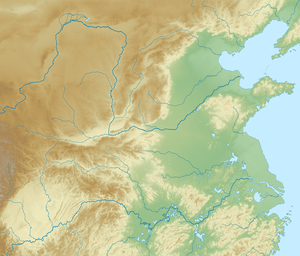Xujiayao
 Shown within China | |
| Location | Hebei and Shanxi, China |
|---|---|
| Region | Nihewan Basin |
| Coordinates | 40°06′02″N 113°58′39″E / 40.10056°N 113.97750°ECoordinates: 40°06′02″N 113°58′39″E / 40.10056°N 113.97750°E |
| History | |
| Periods | early Late Pleistocene |
| Site notes | |
| Excavation dates | 1976,[1] 1977,[1] 1979,[1] 2007,[2] 2008[2] |
Xujiayao, located in the Nihewan Basin in China, is an early Late Pleistocene[3] paleoanthropological site famous for its archaic hominin fossils.[4]
Location
Xujiayao is located on the west bank of the Liyi River, a tributary of the Sanggan River.[5][2] Xujiayao actually consists of two sites, Locality 73113 and Locality 74093.[6][2] Locality 73113 is located near Xujiayao village in Yanggao County, Shanxi,[5] while Locality 74093 is located near Houjiayao village in Yangyuan County, Hebei.[2] Most of the fossils and artefacts were found at Locality 74093.[6]
Discovery and excavations
Xujiayao was discovered by researchers from the Institute of Vertebrate Paleontology and Paleoanthropology (IVPP) in 1974.[6] IVPP carried out excavations in 1976, 1977, and 1979.[6] Later excavations, in 2007 and 2008, were carried out by the Hebei Provincial Institute of Cultural Relics.[2]
The Xujiayao hominin
Twenty hominid fossils were discovered at Xujiayao, consisting of 12 parietal bones, 1 temporal bone, 2 occipital bones, 1 mandibular bone fragment, 1 juvenile maxilla, and 3 isolated teeth.[1][3]
The fossils remains at Xujiayao are difficult to classify and are of an uncertain taxonomic lineage, possibly representing a distinct hominin lineage.[3]
The Xujiayao fossils are characterized by a mix of Homo erectus and Homo sapiens features.[7] The skulls also have a thick cranial vault, at the upper range of Homo erectus pekinensis.[7] The maxilla exhibits features more typical of modern Homo sapiens.[7]
Dental analysis shows that the Xujiayao hominin appears to retain many archaic features found in hominin fossils, such as Homo pekinensis, from the Early and Middle Pleistocene in East Asia, share more similarities with these earlier East Asian hominins, and share some similarities with Neanderthals.[8] While fossil sample Xujiayao 15 had mostly non-Neanderthal features appearance-wise, a CT scan revealed that the inner ear, surprisingly, was arranged in a way that was typical of Neanderthal inner ears.[9]
One of the fossil samples, Xujiayao 11, had an enlarged parietal foramen (a hole in the skull), an extremely rare abnormality that is found in less than 1 out of 25,000 cases in modern humans.[10] Xujiayao 11 is the oldest hominin fossil to exhibit this abnormality.[10]
Fauna
Around 5000 specimens from twenty-one distinct species are represented at Xujiayao.[11] The large majority of the remains belong to Przewalski's horse and Equus hemionus.[11] The next most common remains belong to Coelodonta, Spirocerus (Xujiayao antelope/Spirocerus hsuchiayaocus and Pei's antelope/Spirocerus peii), Procapra and Gazella.[11] Some red deer, sika deer and pig remains were also found.[11]
The Xujiayao hominin excelled as horse hunters,[2] having regular access to animal protein, primarily coming from equids.[12]
Artefacts
Almost 30,000 lithic, bone and antler artefacts were also unearthed at Xujiayao.[7] Tools found at Xujiayao include scrapers, points, gravers, anvils, chopper and spheroids.[7][13] Over 50% of the artefacts consist of finished tools.[13] Over 40% of the artefacts consist of scrapers.[13] The artefacts there include the presence of over 1000 stone spheroids, the most of any Paleolithic site in China.[13]
References
Bibliography
- Norton, Christopher J.; Gao, Xing (Feb 8, 2008). "Hominin-carnivore interactions during the Chinese Early Paleolithic: Taphonomic perspectives from Xujiayao". Journal of Human Evolution. 55: 164–178. doi:10.1016/j.jhevol.2008.02.006.
- Olsen, John W. (Nov 11, 2013). "Chapter 9: Recent Developments in the Upper Pleistocene Prehistory of China". In Soffer, Olga. The Pleistocene Old World: Regional Perspectives. Springer Science & Business Media. pp. 135–144. ISBN 978-94-007-0491-6.
- Liu, Wu; Xiujie, Wu (Mar 23, 2011). "The Hominid Fossils from China Contemporaneous with the Neanderthals and Some Related Studies". In Condemi, Silvana; Weniger, Gerd-Christian. Continuity and Discontinuity in the Peopling of Europe: One Hundred Fifty Years of Neanderthal Study. Springer Science & Business Media. ISBN 978-94-007-0491-6.
- Tu, Hua; Li, Haixu; Xie, Fei; Granger, Darryl E. (February 23, 2015). "26Al/10Be Burial Dating of Xujiayao-Houjiayao Site in Nihewan Basin, Northern China". PLOS ONE. 10: e0118315. doi:10.1371/journal.pone.0118315.
- Wu, Rukang; Jia, Lanpo (1996). "CHINA in the period of Homo sapiens neanderthalensis and contemporaries". In de Laet, Sigfried J. History of Humanity: Prehistory and the beginnings of civilization (PDF). Routledge. pp. 441–445. ISBN 978-92-3-102810-6.
- Wu, Xiu-Jie; Xing, Song; Trinkaus, Erik (March 18, 2013). "An Enlarged Parietal Foramen in the Late Archaic Xujiayao 11 Neurocranium from Northern China, and Rare Anomalies among Pleistocene Homo". PLOS ONE. 8: e59587. doi:10.1371/journal.pone.0059587.
- Xing, Song; Martinón-Torres, María; Bermúdez de Castro, Jose María; Wu, Xiujie; Liu, Wu (Feb 2015). "Hominin teeth from the early Late Pleistocene site of Xujiayao, Northern China". American Journal of Physical Anthropology. 156 (2): 224–240. doi:10.1002/ajpa.22641.
- "Ancient human skull in China has Neanderthal-like inner ear". www.kaogu.com. Retrieved Oct 21, 2015.